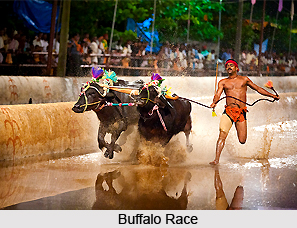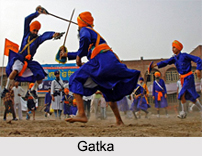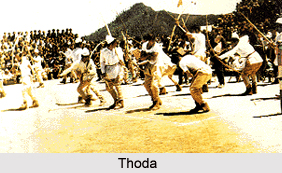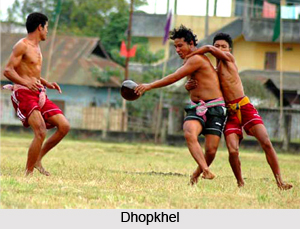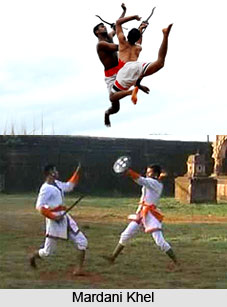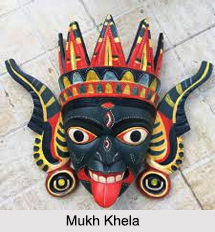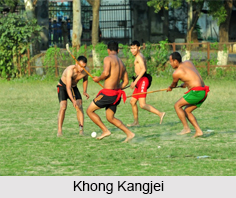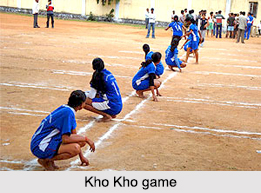 Kho Kho is one of the two most popular traditional tag games, which is often considered to be one of the ancient games of India. The other one is Kabaddi. The word “Kho Kho†has been derived from the Sanskrit verb root “syuâ€, which means to get up and go. The origin of this game is still very uncertain; but some historians believe that Kho Kho is a modified version of the game “Run Chaseâ€. During ancient times, Kho Kho was played in “Raths†or chariots and was known as “Ratheraâ€. The Deccan Gymkhana Club of Pune in Maharashtra, which was baptized by the great Indian leader Lokmanya Tilak, and Bhai Narorkar first sketched the rules and regulations of Kho Kho game.
Kho Kho is one of the two most popular traditional tag games, which is often considered to be one of the ancient games of India. The other one is Kabaddi. The word “Kho Kho†has been derived from the Sanskrit verb root “syuâ€, which means to get up and go. The origin of this game is still very uncertain; but some historians believe that Kho Kho is a modified version of the game “Run Chaseâ€. During ancient times, Kho Kho was played in “Raths†or chariots and was known as “Ratheraâ€. The Deccan Gymkhana Club of Pune in Maharashtra, which was baptized by the great Indian leader Lokmanya Tilak, and Bhai Narorkar first sketched the rules and regulations of Kho Kho game.
Field in Kho-Kho
The ground measurement varies in Kho-Kho based on the age group of the players.
27 x 16 meters for men, women, and junior boys and girls.
23 x 14 meters for sub junior boys and girls
The size of the pole should be 180 cm, out of which 125 cm should be above the ground and the rest inside the ground.
Pole diameter ranges between 9 to 10 cm
Poles can be made of either wood or iron.
Important rules of Kho Kho
After lots of modifications, finally the rules of Kho Kho game have been standardized. And the Rules of Kho Kho are as follows:
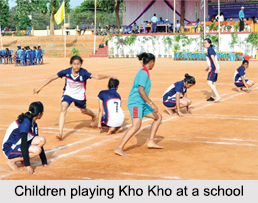 1. Duration:
1. Duration:
(a) Each side consists of 9 players.
(b) An innings will consist of chasing and running turns which will be of 7 minutes duration each. Every match will consist of two innings.
(c) An interval of 5 minutes is allowed after an inning and 2 minutes break is allowed between two turns.
2. The side of the chasers scores one point for putting out each runner.
3. The chaser or the runner has the option to end the turn before the expiry of the allotted time.
4. The captain of the team which wins the toss will have the choice of chasing or running.
5. At the commencement of the game the eight chasers (players sitting in the squares) will sit in the squares facing opposite directions. No adjacent chasers should face in the same direction. The 9th chaser will stand at either of the posts.
6. The runners will fix and coordinate their entry serially with the scorer.
7. With the commencement of the game three runners are to get inside the court. As soon as a runner is put out the next three runners must enter the field before "kho" is given. If a runner fails to enter the field, he/she is given out.
8. A runner goes out of the game by the following means:
(a) If touched by a chaser.
(b) If she/he fails to enter the field when a runner is given out.
(c) If she/he touches the seated chasers twice or after receiving a warning for similar infringement.
9. Rules for the chasers:
(a) "Kho" is to be given from behind a sitting chaser and it is to be said loudly.
(b) The seated chaser shall not get up without getting "kho".
(c) An active chaser shall not recede to give "kho".
(d) An active chaser shall sit down immediately after giving "kho".
(e) After getting "kho" the sitting chaser becomes active and follows the direction he is facing.
(f) An active chaser is not to cross the centre line.
(g) She/He is to take the direction that was initially taken by her/him to the M or N posts.
(h) When an active chaser leaves a post, he/she shall go in the direction of other post remaining on the side of the centre line which he/she was facing before leaving the post.
(i) Chasers are not to obstruct runners while being seated.
(j) The face (shoulder line) of an active chaser must be in a direction he/she has taken. He/She shall not turn his/her face. He/She is only allowed to turn his/her face parallel to the centre line.
(k) If a foul is committed by an active chaser she/he will be directed to go in the opposite direction of her/his chaser as indicated by the umpire and if a runner is put out by this act she/he will not be given out.
(I) When an active chaser lets go his/her hold of the post or goes beyond the rectangles he/she is known as leaving the post.
10. Scoring in Kho Kho
The side of the chasers scores 1 point for putting out each runner. If one team scores 9 points more than the other team, the winning team may ask the losers to chase without losing their option to chase afterwards. A substitute shall be allowed to replace an injured player at the discretion of the referee.
Officials in Kho Kho
The officials in the Kho Kho game are the ones who manage the entire game so that it proceeds according to the rule, are:
Two Umpires: They supervise the game in their respective halves, divided by the centre line. A foul is indicated by continuous short whistles till the foul is corrected. An "out" is declared by a short whistle.
Referee: The referee helps the umpires and gives the final decision in case of any difference between them and amongst the players.
Time-keeper: The Time-keeper keeps the record of time and hands it over to the scorer at the end of an innings. The turn is usually started by blowing the time-keeper’s whistle: one long and one short. The end of the turn is indicated by a long whistle.
Scorer: The scorer keeps a record of runners who are out and makes them sit.
Assistant Scorer: The Assistant Scorer helps the scorer in carrying out all the functions.
Rules in Kho Kho Tournament:
A Kho-Kho match is played in 2 innings with 9-9 minutes of duration in each innings. A 9 minutes of chasing is followed by 3 minutes of interval and then again another 9 minutes of chasing is followed by an interval of 5 minutes. This means every team get 9 minutes to chase and 9 minutes to defend in every match.
1. Team Composition:
(a) Each team consists of 12 players, with 9 players on the field and 3 substitutes.
(b) The team must have a captain who is responsible for leading and making tactical decisions.
2. Field Dimensions:
(a) The playing field is a rectangular shape with a length of 27 meters and a width of 16 meters.
(b) There are two rectangles at both ends of the field, known as "courts," each measuring 16 meters by 2.75 meters.
3. Duration of Play:
(a) A Kho Kho match is played in two innings.
(b) Each inning has a fixed duration of 9 minutes.
(a) Teams switch between chasing and defending roles at halftime.
4. Chasing and Defending:
(a) In an inning, one team assumes the role of chasers while the other team defends.
(b) The chasers must tag the defenders to eliminate them from the field.
(c) Defenders try to avoid being tagged and stay in the game.
5. Tagging Rules:
(a) A tag must be made below the waistline of the defender to be considered valid.
(c) Defenders who are tagged must leave the field and join the opponents` side.
6. Scoring:
(a) The team earns one point for each defender they successfully tag.
(a) The team can also score a "bonus" point by touching the centerline and returning safely to their court without being tagged.
7. Dodging and Evasion:
(a) Defenders can dodge and evade chasers by running within the court lines.
(a) They can also form a chain with their teammates to protect themselves.
8. "Kho" Call:
(a) When a chaser is close to tagging a defender, they can shout "Kho" to signal the attempt.
(a) The defender being targeted must then quickly leave the field to avoid being tagged.
9. Winning the Game:
(a) The team with the most points at the end of both innings wins the match.
(a) In case of a tie, the team that tagged the most defenders wins.
10. Player Substitution:
(a) Substitutes can enter the field only during stoppages in play and with the referee`s permission.
11. Code of Conduct:
(a) Players must adhere to fair play and sportsmanship.
(a) Unsportsmanlike conduct, foul play, and the use of offensive language are strictly prohibited.
12. Referee`s Authority:
(a) The referee has the final authority in enforcing the rules and making decisions during the game.
(a) Disputes and disagreements must be resolved through the referee`s judgment.
13. Protective Gear:
(a) Players are required to wear appropriate sports clothing and footwear.
(a) The use of any equipment that could cause harm is not allowed.
14. Injuries:
(a) In case of injury, the injured player must leave the field, and a substitute can replace them.
15. Spectator Etiquette:
(a) Spectators must adhere to proper conduct and show respect for the players and officials.
16. Penalty for Violations:
(a) Violations of the rules may result in penalties, such as awarding points to the opposing team or player suspension.
